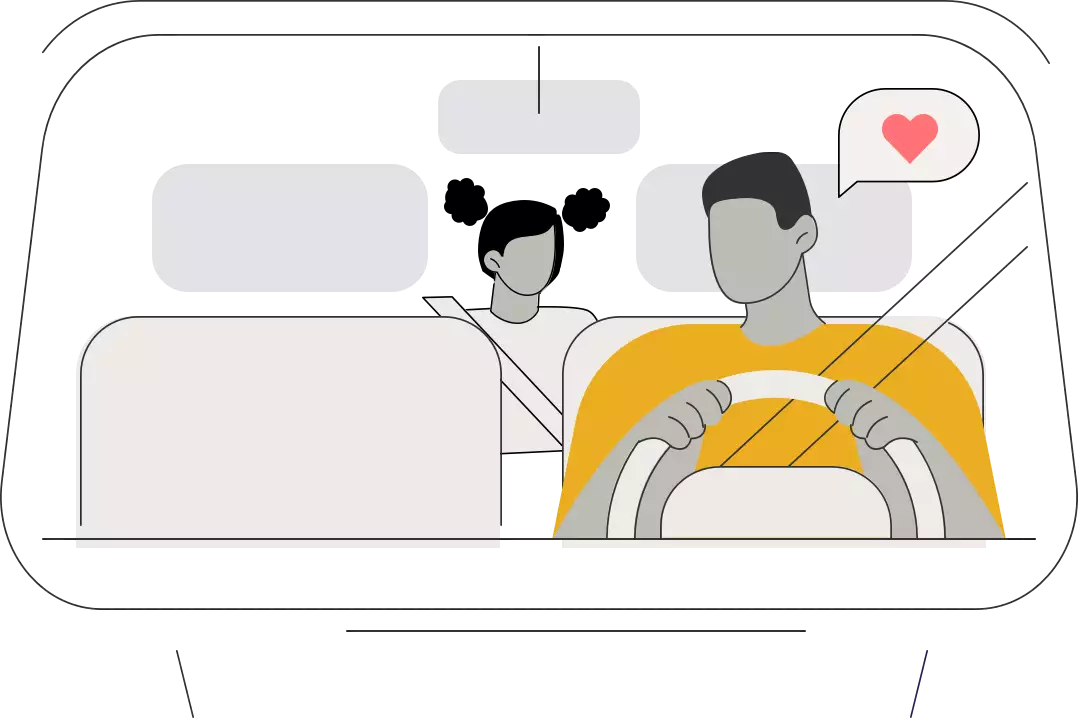Tips for Newborns to Teens
We all learn from the day we’re born, and thankfully we keep learning every day after that. Every day is a new chance to teach your kids how to be distraction-free on and off the road. Here’s how to do that at every age.

0–5-year-olds
From the first time you buckle your child into their car seat, explain what you are doing and why you’re doing it. You could say something like, “Mommy’s going to buckle you in to keep you secure and then put her phone in the back seat so she can focus on the road and keep us safe.”
As babies grow into toddlers, they start showing their independence, for better or worse, depending on the minute. The terrible twos and threes can be a lot, especially when you’re trapped in a vehicle together. If you don’t have another passenger who can help you, pull over to a safe place to take care of anything your child needs.
If there’s nowhere to safely pull over, explain calmly, “You’re upset, and Daddy’s upset too. We need to wait until there’s a safe place to pull over, and then I can help you.”
6–12-year-olds
They’re getting older but they’re not exactly wiser just yet. And they can still be a distraction themselves. Here’s how to make safe driving a family affair.
- Explain that driving takes a lot of concentration and skill, and you need quiet and calm to keep everyone safe.
- Tell them about all the ways someone could drive distracted and why it’s important for you to stay focused on the road.
- Set rules upfront about what is OK and what isn’t in the vehicle (it’s not cool to throw things).


- Teach them about natural consequences. If they drop their toy during the ride, sorry, Charlie, you won’t be able to pick it up.
- Pull over to a safe place if things get out of hand. You can calmly say, “You’re acting unsafe, and that could cause a crash. Once you calm down, we can get back on the road.”
- Make the ride fun by playing a game (Distraction Action) or having a sing-along to their favorite music.
- Encourage your kids to speak up if they see you or another person driving distracted.
13–18-year-olds
Oh, the teen years. The good news is you can teach your teens about safe driving practices in a more hands-on way.
- Keep the conversation going about distracted driving and be a positive role model. Drive the way you want them to drive. You are their role model on and off the road.
- Explain what your local driving laws are, including what’s required under the GDL program, along with road signs, right-of-way rules and speed limits.
- Teach them about the importance of maintaining a vehicle (checking fluids, changing a tire, jumpstarting a battery) and having emergency supplies on hand. Get them involved in scheduling oil changes and checkups.
- Explain your actions while driving. This is called commentary driving, and it’s important for helping your teen learn how to drive. Talk about how and why you start, turn, back up, change lanes and park like you do so they start to be alert in the vehicle long before they get their learner’s permit.


- Give them random pop quizzes to see how much they’ve learned. You can also have them point out hazards while you’re driving so they start to build awareness and focus.
- Pull over if you need to do any non-driving activity, or ask your teen to handle it instead.
- Together, create an agreement that you both sign that explains your commitment to driving distraction-free and complying with GDL and other rules.
- Once they start driving, be a calm and supportive supervisor. Help them spot when they get distracted and how to stop it.
- Get help from trusted friends and family members if you or your teen need a break from each other. Sometimes enlisting a non-parental supervisor is the best way to go.
- Stay involved once your teen has their intermediate or full license. Provide ongoing support and guidance to help your teen drive safely by buckling up, being distraction-free and staying sober.
- Do not text or call your teen when you know they are driving or think they might be driving.

